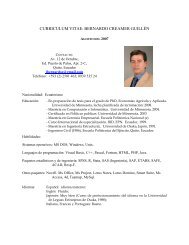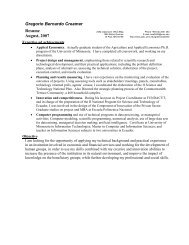Water-Quality Trading: Can We Get the Price of Pollution Right?
Water-Quality Trading: Can We Get the Price of Pollution Right?
Water-Quality Trading: Can We Get the Price of Pollution Right?
You also want an ePaper? Increase the reach of your titles
YUMPU automatically turns print PDFs into web optimized ePapers that Google loves.
References[1] Anderson, D.M, P.M. Glibert, J.M. Burkholder. (2002). Harmful Algal Blooms and Eutrophication:Nutrient Sources, Composition, and Consequences. Estuaries, 25(4), 704–726[2] Atkinson, S.E., T.H. Tietenberg. (1982). The Empirical Properties <strong>of</strong> Two Classes <strong>of</strong> Designsfor Transferable Discharge Permit Markets. Journal <strong>of</strong> Environmental Economics and Management,9(2), 101-121.[3] Breetz, H.L., Karen Fisher-Vanden, Laura Garzon, Hanna Jacobs, Kailin Kroetz, and RebeccaTerry. (2004). <strong>Water</strong> quality trading and <strong>of</strong>fset initiatives in <strong>the</strong> U.S.: A comprehensive survey.Dartmouth College, New Hampshire.[4] Elliott, J.M. (2000). Pools as refugia for brown trout during two summer droughts: troutresponses to <strong>the</strong>rmal and oxygen stress. Journal <strong>of</strong> Fish Biology, 56, 938-948.[5] Elliott, J.M. and M.A. Hurley. (2001). Modelling growth <strong>of</strong> brown trout, Salmo trutta, in terms<strong>of</strong> weight and energy units. Freshwater Biology, 46, 679-692.[6] Environomics. (1999). A summary <strong>of</strong> U.S. effluent trading and <strong>of</strong>fset projects. Prepared forU.S. EPA Office <strong>of</strong> <strong>Water</strong>.[7] Fang, Feng, K. William Easter, and Patrick L. Brezonik. (2005). Point-nonpoint source waterquality trading: a case study in <strong>the</strong> Minnesota River Basin. Journal <strong>of</strong> <strong>the</strong> American <strong>Water</strong>Resources Association, 41(3), 645-658.[8] Farrow, R.S, Shultz, M.T., Celikkol, P. Van Houtven, G.L. (2005). <strong>Pollution</strong> <strong>Trading</strong> in <strong>Water</strong><strong>Quality</strong> Limited Areas: Use <strong>of</strong> Benefits Assessment and Cost-Effective <strong>Trading</strong> Ratios. LandEconomics, 81(2), 191-205.[9] Helfand, G.E. and B.W. House. (1995). Regulating Nonpoint Source <strong>Pollution</strong> under HeterogeneousConditions. American Journal <strong>of</strong> Agricultural Economics, 77(4), 1024-1032.[10] Hung, Ming-Feng and Daigee Shaw. (2005). A trading-ratio system for trading water pollutiondischarge permits. J. <strong>of</strong> Env. Economics & Mgmt., 49, 83-102.[11] King, Denis M. (2005). Crunch time for water quality trading. Choices, 20(1), 71-75.[12] King, Denis M. and Peter J. Kuch. (2003). Will nutrient credit trading ever work? An assessment<strong>of</strong> supply and demand problems and institutional obstacles. The Environmental LawReporter. Washington, DC: Environmental Law Institute.[13] Mauzeralla, D.L., B. Sultanc, N. Kima, and D.F. Bradford. (2005) NOx emissions from largepoint sources: variability in ozone production, resulting health damages and economic costs.Atmospheric Environment 39, 2851–2866.[14] McGartland, A. and W.E. Oates. (1985). Marketable Permits for <strong>the</strong> Prevention <strong>of</strong> EnvironmentalDeterioration. J. <strong>of</strong> Env. Economics and Mgmt., 12, 207–228.[15] Montgomery, W. David. (1972). Markets in licenses and efficient pollution control programs.Jour. <strong>of</strong> Economic Theory, 5, 395-418.23



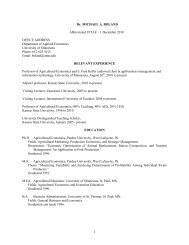
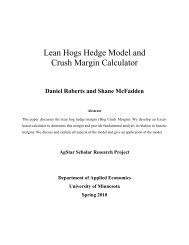
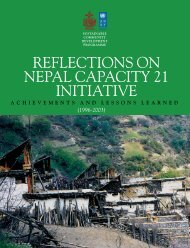
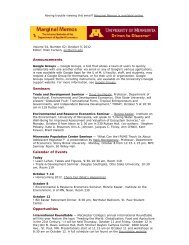

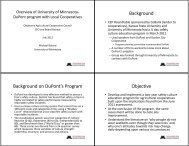
![Publications Since 2000[1].docx](https://img.yumpu.com/30237513/1/190x245/publications-since-20001docx.jpg?quality=85)

